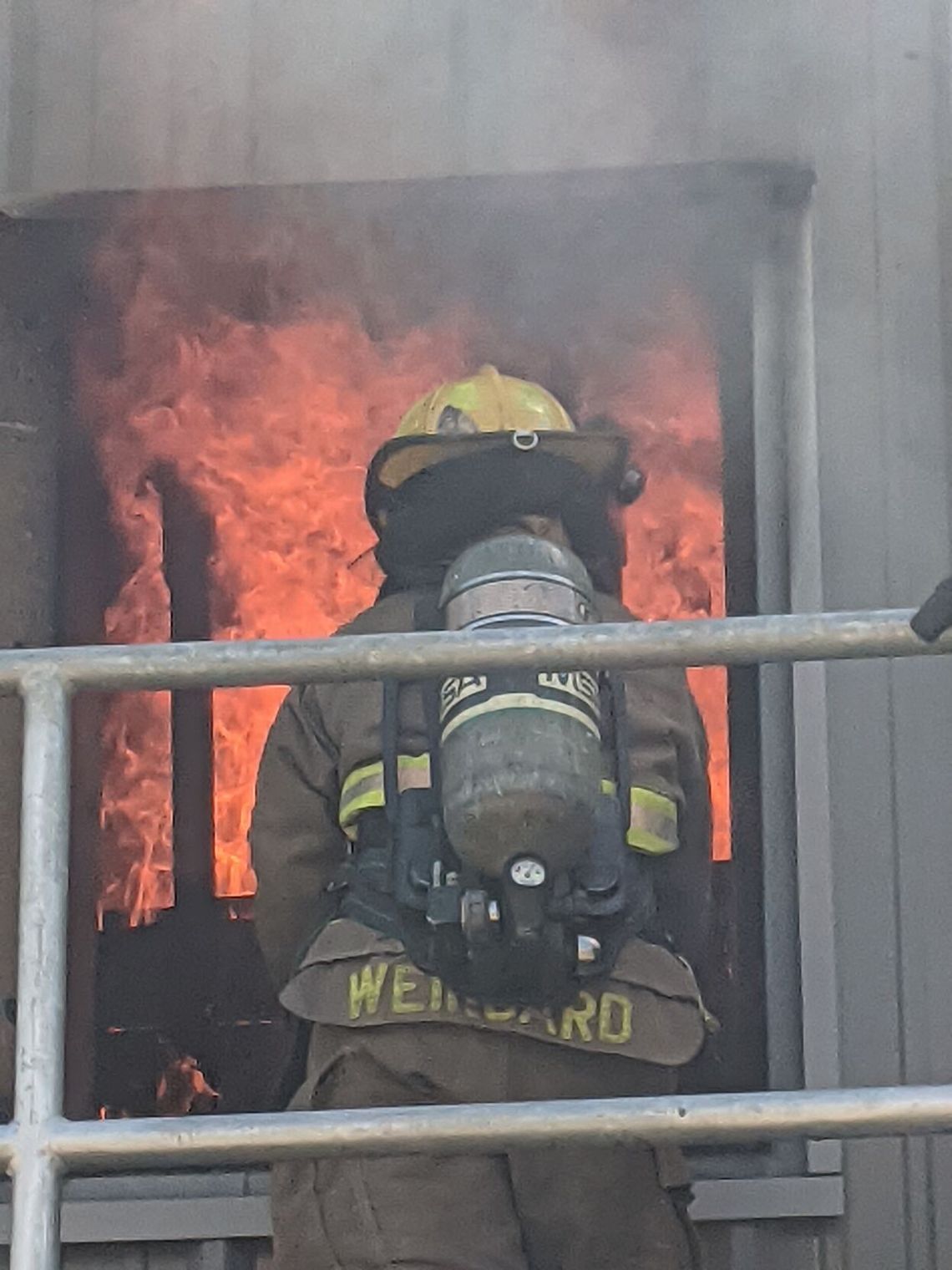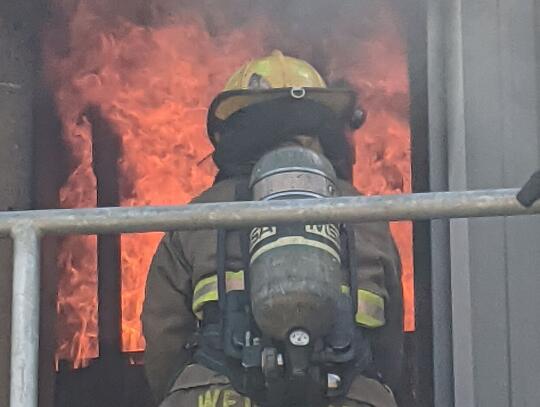Editor’s note: This is the second of series of stories about the James E. Blackburn Sr. Public Safety Training Center in Ware County. Today’s entry examines the fire training elements of the complex.
By DANNY BARTLETT
Staff Writer
The $1.2 million James E. Blackburn Sr. Public Safety Training Center is a state-of-the-art facility that is becoming a regional training stop for fire and law enforce agencies all across southeast Georgia.
Jesse Jordan, the administrator of the center, praised the Ware County Commission and the facility’s planners saying, “this facility was built right and will be in use for a very long time.”
Waycross Fire Chief David Eddins was on hand, and explained what the three recruits were at the training center for on the day The Journal-Herald received a tour of the complex.
“This is part of their hiring process where we have to sign off in order for them to be eligible for state certification,” the veteran Chief said. “Today, we’re out here for these three to get their live fire training that’s required by the Georgia Firefighter Standard and Training Council. That’s actually the certifying agency for the firefighters in Georgia.
“They won’t do just one exercise. They’ll do multiple exercises from the ground floor up; they’ll go from the second floor down; they’ll do a variety of different scenarios in there that we can check off and they’ll have paperwork over there under the command tent.”
Eddins continued about why this center is so important, saying that they have people monitoring the fire temperature on a computer as well as the vitals of the recruits while that are in the building. He said it woudl take a minimum of six instructors to put the recruits through the day’s training.
The burn building is so well designed and equipped that it can be used, not only for the aforementioned scenarios, but also for fire after fire after fire because it’s insulated with a high tech material called Padgenite. The buildings walls are so well insulated, they can withstand temperatures up to 1700 degrees F.
Eddins explained why the old way of building fires for fire training was inadequate.
“We would stack the Conex box (these are the boxes that are used for shipping that can be offloaded from a ship and put on a tractor-trailer), but the way it was designed and burned, we actually burned the roof out of it so you couldn’t contain the smoke,” he said. “The biggest thing we were trying to do was reduce visibility, not so much the heat and flames. You want to put the firefighters in that environment where they can’t see and they have to depend on their senses here.
“Well, when you can’t cover the hole to keep the smoke in, it’s not really giving them that type of situation. This burn building allows them to get into that. They have to travel through rooms, which if you’re inside a house, you may have to go through a couple of rooms doing search and rescue before you actually get to where the fire rooms are.”
The burn building was designed so that different scenarios as well as different environments could be simulated in a real live fire situation. Eddins said. He said great planing and detail went into its design.
“We met, took drawings, and made changes. There were a lot of meetings on this, it wasn’t put up with little to no thought,” he said. “We looked at a scenario of a hotel with a balcony. We can simulate a commercial environment, a residential environment. We tried to look at what all can we do? Can they come right in and get to where the fires are? Do we make them go from the ground floor to the upstairs doing search and rescues?
“Every fire we go to is different. The burn building gives us the opportunity to train differently every single time we come. We may come and spend a day and we may run everybody through one scenario, then we’ll change that scenario up and run them back through it again.”
The burn building replaces the antiquated method of training in an actual house. Standards from the Environmental Protection Agency and the Environmental Protection Division, its Georgia counterpart have made it counterproductive, Eddins said.
“The EPA and the EPD have made that virtually impossible,” he said. “One of the first things we have to do is if the owner wants to donate (house), they have to go and do an asbestos study. I’ve no earthly idea what that costs now.
“That’s the first thing. If asbestos is in there, we’re not able to use it. Then there’s the shingles, the flooring, the wiring; all the stuff that can present a health hazard has to be removed. So, by the time you do everything they ask you to do, the house isn’t in a position to use. You’ve opened stud walls and things that become entrapment hazards.
“That’s not something they’re going to see inside a regular everyday house. So why put them in that environment? If you drive through Waycross, you will see the houses are too close together. What we look at in the fire service is we call an exposure. If a building on fire is within 40 feet of another building that’s on fire, we say that’s an exposure and we need to direct a water line to cover it from the heat and the flames of the fire. If you ever go to one and they’re actually fighting that house fire, but you see another line directed at a house that isn’t on fire, we’re protecting that exposure.
“Then the last thing, and probably most important is the condition of the houses. By the time we’re able to do get houses ready, they’re not in living condition. So now we’re putting our firefighters in a harmful situation, whether it’s rotted floors, the integrity of the structure, period, has been compromised. It’s just not a good thing at all to do.”
Captain Thomas Haddock was on the computer that was recording all the vital information that was going on during the training. There is a data logger on the outside of the burn building that runs to thermal couples in the burn building. In the burn building, there are three burn rooms that have thermal couples in the ceiling and in the wall. The thermal couple measure and record the temperatures in the building. They are connected via Wi-Fi to Haddock’s computer.
Per the manufacturer, to get the most life out of the insulation, which is expensive, is to keep the ceiling below 800 degrees. If the temperature starts to get to 800 or exceed it, they have water hoses, called safety lines, ready to extinguish it or just bring the temperature down. By keeping the temperature under 800 degrees, the building does not get worn out prematurely and the expensive insulation has a longer useful life.
The optimum temperature in the wall is about 350 degrees. That’s the limit of the turnout gear and is the standard of the statewide Fire Academy. It’s a safety issue the trainers take very seriously, at about a 36-inch level, to be below 350 degrees. That’s an absolute. The safety instructors will stop the training and immediately cool the fire down.
Data is collected in case there’s an injury or other incident that results in an investigation. The data is recorded, and in an investigation, they can determine exactly what was happening at any point of the training and can rectify the procedures for future training.
Nothing in the burn rooms is combustible except the pallets that are in the burn pans.
“What we try to do is hit a balance. We want the most fire burning when the fire instructor hits the door to extinguish it,” Haddock said. “Anything before that it is putting heat and stress in the building that’s unnecessary.”
Haddock also explained the value and importance of the insulation.
“Great thing about the insulation is we can train all day,” he said. “A concrete building heats up and it holds the heat. It gets to a point where the room becomes so hot that you’re basically done for the day because the ambient temperature can’t cool down for you to do another training cycle.
“It’s just instantly too hot. We give this insulation 20 or 30 minutes to ventilate and cool, and the room will be about a hundred degrees.”
From the leadership team at the top down to the new recruit, all sing the praises of the capabilities of the burn building. When you think of firefighters like we see in firefighting shows on TV in the firehouse waiting for a call to come in, that’s not the norm in the Waycross and Ware County houses.
The training is so good and realistic, one firefighter said, “We’d rather be out here training than sitting around in the firehouse.”
Battalion Chief Jimmy Brown added, “This facility is as good as anywhere and provides us a place to train where we don’t have to go off and leave our families.”
That sentiment is prevalent among the ranks, and reinforces the SPLOST revenues raised by the taxpayers and spent on this facility was money well spent.












